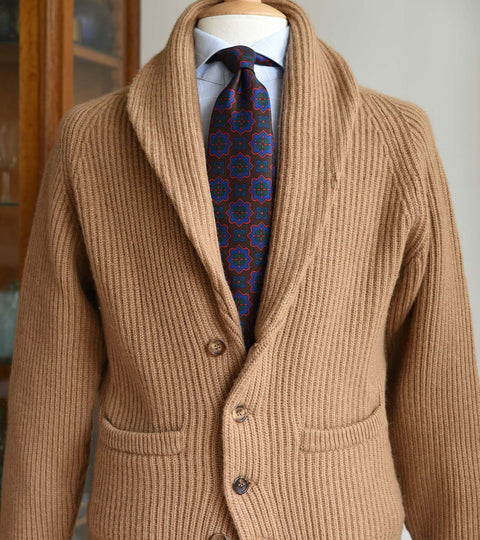By Tim Mureau -
Scotland is a beautiful part of the world that brings us a good amount of the
finest things in life. Think of Scottish smoked salmon, whisky, shortbread or a fantastic sport like golf. But even better is the large range of textiles that the country produces, which are the basis of high-quality menswear. Their most well-known textiles are probably tartan and tweed. But another important type of textile with a rich tradition in Scotland is knitwear. Knitwear has become more important over the last 10 years in classic menswear, and it is used both casual as well as in more formal outfits. In Scotland there is, especially in the so called ‘’Scottish Borders’’ region, a long tradition in producing knitwear.
A tradition of knitwear in the Scottish Borders A couple of years ago I had the pleasure of visiting this area of Scotland and especially the town of Hawick where the best knitwear producers of the world are based. This town has a history in the textile industry that dates back on paper till 1650 when the first craft guild was formed in Hawick. But probably the industry in that little town is even older than that. In those days knitwear was not the main focus but there was a strong woollen industry already for fabrics and carpets.

It was in 1771 that Bailie John Hardie who was nicknamed ‘’Hawick’s father of the hosiery industry’’ installed the first four knitting frames in Hawick, heralding the start of the town’s knitwear tradition. It was also the moment that the textile industry in the town started to grow quickly. In those days this was all done in homes of craftsmen who knew how to do this. A little bit like we still see on the Isle of Harris, home of the famous Harris Tweed, which is often woven in sheds of farmers on the Islands. The so-called independent weavers. And of course, in those days they were not producing yet fine pullovers and cardigans but mainly stockings, a very important product in those days.
Growth of the knitwear industry In 1815 there came an end to the spinning, weaving and knitting in individual homes and the first mill buildings were set up. The process moved from the individual craftsmen to these new mills, and the first companies were formed, companies that still exist today. And as the time moved forward there were new products introduced beside the stockings.

Well actually the stockings evolved into some kind of ‘’combination’’ garments and eventually into knitted underwear. Something we cannot imagine being comfortable nowadays, but back then was probably very useful. From there the products have slowly moves towards knitted outerwear in the form of pullovers and cardigans as we know them today. In 1830 the first mill in Hawick started to use cashmere, and many would follow afterwards. This was the introduction of extremely luxurious knitwear which has become more important through the years. With ups and downs, mainly because of competition that started to be active from overseas, the industry survived up till today and is favoured by high end couturiers, fashion houses and Savile Row tailors as well as smaller brands and shops that care a lot about providing the highest quality possible. For example, Amidé Hadelin which has just launched a collection of
knitwear made in Hawick.
Hawick's unique location Back to my visit in Hawick a couple of years ago. After I was picked up at the airport by one of the people that work for a knitwear mill we drove through a magnificent Scottish landscape called the Scottish Borders.

We arrived in the beautiful town of Hawick where one thing immediately occurred to me, the river with its strong current. This is such a typical sign of a town with textile mills. Nearly all towns with textile mills I’ve visited have a river with a strong current and usually clear water. This is important for producing any form of textile. While in the past the mills were powered by the strong current of the water, the clear water was and is used to wash the textiles and give them a soft feeling. Driving further into town I saw one mill after another, they’re basically all neighbours. It’s funny to realise how such a small town is so important to the world of quality textiles and serves big cities like London, Paris, Milan, Tokyo and New York with the finest quality knitwear available.
Devoted craftsmen The mills I’ve visited showed me clearly where the quality came from. Of course, there are differences between the mills as we see in some of them more modern machines, while others are still swearing by old machines that are basically (close to) antique. But this frankly doesn’t make the difference in quality, and it isn’t the yarn either as the same yarns can be used by other knitwear mills elsewhere in the world. Does the water from Hawick make the difference then? Well, maybe… It certainly helps and it is a charming feeling.

But the real difference is in the quality control and the devotion the people from Hawick have to their products. It’s a tradition they are proud of, and they would like to keep up. They realise that they can only continue that if they keep up with the quality and therefore, they are providing the finest knitwear in the world. So, what you will see in the Hawick knitwear mills are devoted people that check every single inch on mistakes, put the yarn on the looms with the greatest precision, do the stitching where necessary with great care and even pack the goods with a huge amount of respect. And even though the knitting itself is done on a machine, the quality of the products is certified by all the handwork done in the overall production process by the proud and devoted craftsmen of Hawick.

Tim Mureau – was born in Holland, and has always been travelling around the world looking for the finest artisans. He’s interested in all things handmade, and can’t stop talking about fine watches and menswear. He has worked in various menswear stores, has been a sales representative for various artisanal clothing manufacturers, and is now active as a journalist focused on watches and menswear. Check out his page for more interesting menswear reads and interviews.







